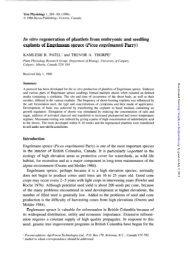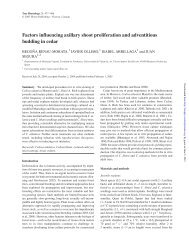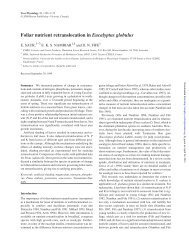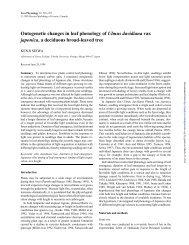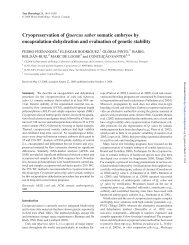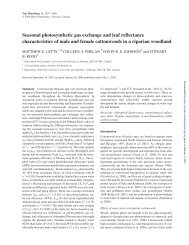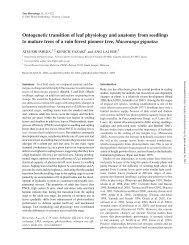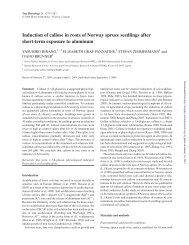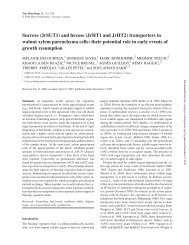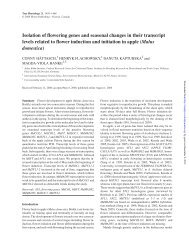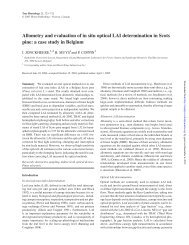Hara: the effect of xylem structures - Tree Physiology
Hara: the effect of xylem structures - Tree Physiology
Hara: the effect of xylem structures - Tree Physiology
Create successful ePaper yourself
Turn your PDF publications into a flip-book with our unique Google optimized e-Paper software.
4<br />
Figure 3. Xylem water potential as measured in nondehydrated, dehydrated and rehydrated stem segments cut from <strong>the</strong> plants 1 and 12 h after<br />
rewatering in Q. serrata (A) and B. platyphylla (B). Mean ± SD (n = 3). **P < 0.01 and ***P < 0.001 denote significant differences from<br />
nondehydrated segments for Dunnett’s test.<br />
obtained by dividing Kinit by <strong>the</strong> functional <strong>xylem</strong> crosssectional<br />
area, was used as an indicator <strong>of</strong> <strong>the</strong> recovery <strong>of</strong><br />
hydraulic conductivity to rule out embolism in situ. Rehydration<br />
experiments were conducted on three plants in<br />
each 1- and 12-h rehydration period for both species. In<br />
addition, out <strong>of</strong> 17 plants used for dehydration experiments,<br />
three plants before dehydration and three plants after<br />
moderate dehydration, which were <strong>of</strong> <strong>the</strong> same<br />
dehydrated condition immediately before rewatering, were<br />
selected and used for a comparison <strong>of</strong> Ks or <strong>xylem</strong> water<br />
potential at different water statuses (see Figures 2 and 3).<br />
Xylem anatomy<br />
We analyzed <strong>the</strong> <strong>xylem</strong> anatomy on various plant water<br />
statuses—before and after dehydration (about 0 and −2<br />
MPa in Ψ <strong>xylem</strong>, respectively) and 1 and 12 h after rewatering—to<br />
compare <strong>the</strong> changes in functional and embolized<br />
vessel size distribution with water status. Segments for anatomical<br />
measurements were excised underwater from <strong>the</strong><br />
same stems and a significantly closer position where hydraulic<br />
measurements were conducted. They were perfused<br />
with 0.1% wt/vol. <strong>of</strong> 0.1-µm-filtered safranin dye to distinguish<br />
functional vessels from embolized ones (Sperry et al.<br />
1994, Kondoh et al. 2006). Dye perfusion was performed<br />
in <strong>the</strong> same setting as that <strong>of</strong> hydraulic measurements under<br />
hydrostatic pressure <strong>of</strong> 30 cm hydraulic head for Q.<br />
OGASA ET AL.<br />
serrata and 60 cm for B. platyphylla. After dye perfusion,<br />
30-µm-thick cross sections were obtained from <strong>the</strong> middle<br />
part <strong>of</strong> dye-perfused segments using a sliding microtome<br />
and observed using a stereoscopic microscope. For each<br />
cross section, we randomly chose a 30° (inner-angle) sector<br />
<strong>of</strong> <strong>xylem</strong> that was delimited continuously by two radial<br />
rays from <strong>the</strong> pith to cambium and measured all<br />
functional and embolized vessel numbers and lumen areas<br />
within this sector for each growth ring. The stained functional<br />
vessel and unstained embolized vessel diameters<br />
were calculated as <strong>the</strong> diameter <strong>of</strong> a circle with an area<br />
equal to <strong>the</strong> measured lumen area. In addition to <strong>the</strong><br />
vessel diameter distribution in <strong>the</strong> 5-µm size class for current<br />
and 1-year-old <strong>xylem</strong>, we calculated <strong>the</strong> percentage<br />
number <strong>of</strong> functional or embolized vessels to that <strong>of</strong> all<br />
vessels belonging to each size class to assess <strong>the</strong> dependence<br />
<strong>of</strong> vessel size on sensitivity to dehydration and rehydration.<br />
We measured <strong>the</strong> vessel diameter using three<br />
cross sections cut from each three plant-stem segment<br />
for each water status and from three additional segments,<br />
and analyzed <strong>the</strong> current and 1-year-old <strong>xylem</strong> separately.<br />
Theoretical specific hydraulic conductivity<br />
Based on Poiseuille’s law for ideal capillaries, <strong>the</strong>oretical Ks<br />
(kg m −1 MPa −1 s −1 ) was calculated for <strong>the</strong> only stained func-<br />
Table 1. Percentage <strong>of</strong> <strong>the</strong> functional vessel number on each <strong>xylem</strong> and <strong>the</strong> current <strong>xylem</strong> contribution to whole-<strong>xylem</strong> specific conductivity<br />
(K s), as calculated from <strong>the</strong> functional vessel diameter for well-watered plants <strong>of</strong> Q. serrata and B. platyphylla. Mean ± SD (n = 3 per species).<br />
Percentage <strong>of</strong> functional vessels Current <strong>xylem</strong> contribution in K s (%)<br />
Current <strong>xylem</strong> 1-year-old <strong>xylem</strong><br />
Q. serrata 60.6 ± 8.7 21.5 ± 18.6 99.5 ± 0.5<br />
B. platyphylla 100.0 ± 0.0 100.0 ± 0.0 48.6 ± 0.0<br />
TREE PHYSIOLOGY<br />
Downloaded from<br />
http://treephys.oxfordjournals.org/ by guest on December 10, 2012



